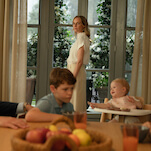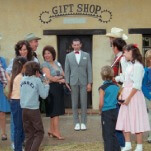Ode to Marshall and Lily: The true central couple of How I Met Your Mother
When trying to establish the legacy of How I Met Your Mother, it’s easy to get bogged down in the lackluster late-season shenanigans (apparently Ted and Robin had unresolved feelings for each other?), running jokes run (wait for it) directly into the ground, and a finale so controversial it retroactively negated the entire premise the show was built on. So appalling are these indignities that they overshadow the show’s crowning achievement: The defining marriage of a television generation, between Marshall Eriksen (Jason Segel) and Lily Aldrin (Alyson Hannigan). With Segel and Hannigan in roles that superficially appear to be standard fare for romantic comedy bit players—that of the wizened, long-standing couple who advise the protagonist in the ways of romance—How I Met Your Mother elevated the form. Through their interactions with protagonist Ted Mosby (Josh Radnor), they detailed how twisty the road to true love can be. But the series’ true innovation is in how that veteran couple gathered all its wisdom.
As detailed in How I Met Your Mother’s extensive backstory—available for revisiting as part of the complete series DVD set due September 23—Marshall and Lily met in their freshman year at Wesleyan University. Speaking as someone who immediately fell into a relationship (and ultimately married) the boy I met on the first day of college, How I Met Your Mother did so many things right in relating what it is to find yourself committed to another person when you’re both still children. The ramifications of that youthful coupling were most clearly illustrated in the show’s first two seasons; with Lily uncertain if she’d sacrificed her dreams for a loving relationship, the pair broke off its engagement. Even after the couple reconciled, it took time and effort for the wounds of their estrangement to heal. Their time apart resonated throughout How I Met Your Mother’s other relationships, particularly the friendship of Lily and Ted. Being left behind to pick up the pieces with Marshall in the wake of Lily’s decision left Ted angry and burdened with resentment long after Marshall’s had dissipated.
Marshall and Lily’s separation exposed weaknesses in their relationship’s foundation. Lily’s lingering doubts about sacrificing her passion and future in art—along with her difficulty communicating her concerns—were a hidden fault line the series was wise to explore. Not only in the first two seasons, but again in the series’ final stretch of episodes, when the Marshall-and-Lily story remained the show’s most emotionally satisfying go-to. In the early going, that storyline gave the characters the time and perspective to evaluate whether those weaknesses were things that they could or (more importantly) want to fix. By addressing this doubt straightforwardly in How I Met Your Mother’s early seasons, Marshall and Lily’s relationship formed a bulwark the rest of the characters could tether to. Even when the couple revisited these issues in the final season, they were resonant in a way that the Ted/Robin/Barney/Mother merry-go-round never was. (This is in no small part thanks to sterling performances by Segel and Hannigan, who from day one inhabited the couple with deeply humane, lived-in—but still uproarious—energy. The thought that they were not actually a long-existing couple beggared belief.) Having addressed such vital, haranguing issues head-on, their romance was allowed blossom and exist in a place of loving rejoinders, as opposed to the biting, acid-tongued retorts of most lengthy sitcom relationships.
And the broken engagement was just one of many realistic trials the couple navigated during their time together: The series also saw the duo address (repeated) job dissatisfaction, situational depression, feared infertility, and the disappointment and loss one can experience with a parent. The humor was inherent in each of these stories, but it was always clear that there were true stakes involved. To watch Marshall and Lily navigate these situations—even in ridiculous or heightened fashion—was to see what it means for two people to survive an ordeal as individuals, while allowing it to strengthen their bond as a couple.



![HBO teases new Euphoria, Larry David, and much more in 2026 sizzle reel [Updated]](https://img.pastemagazine.com/wp-content/avuploads/2025/12/12100344/MixCollage-12-Dec-2025-09-56-AM-9137.jpg)




































